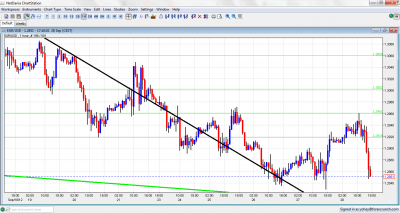EUR/USD first enjoyed the Spanish budget release which included a statement regarding no need for an official bailout. However, fear about the upcoming release of the bank stress tests and a Moody’s downgrade is taking its toll on the common currency. Concerns about global growth also weigh on the euro and help the dollar regain ground. Today is the last day of the week, month and quarter, so lots of volatility is not surprising. Where will the pair end the week?
Here’s an update about technical lines, fundamental indicators and sentiment regarding EUR/USD.
EUR/USD Technical
- Asian session: Euro/dollar remained high above 1.2920 during this session before it fell in the European session..
- Current range: 1.2814 to 1.2920.
Further levels in both directions:
- Below: 1.2814, 1.2750, 1.2670, 1.2624, 1.2587, 1.2520 and 1.2460.
- Above: 1.2920, 1.2960, 1.30, 1.3060, 1.3105, 1.32, 1.3290, 1.34, 1.3437, 1.3480 and 1.3540.
- 1.2920 has strengthened in resistance as the pair trades lower.
- 1.2814 is the next support level.
Euro/Dollar under pressure as markets await Moody’s – click on the graph to enlarge.
EUR/USD Fundamentals
- 6:00 German Retail Sales. Exp. +0.5%. Actual +0.3%.
- 6:45 French Consumer Spending. Two releases: +0.4% and -0.8%.
- 9:00 Euro-zone CPI Flash Estimate. Exp. 2.4%. Actual +2.7%.
- 12:30 US Personal Spending. Exp. +0.5%. Actual +0.5%.
- 12:30 US Personal Income. Exp. +0.2%. Actual +0.1%.
- 12:30 US Core PCE Price Index. Exp. +0.1%.
- 13:45 US Chicago PMI. Exp. 52.9 points. Actual 49.7 points.
- 13:55 US Revised consumer sentiment. Exp. 79. Actual 78.3 points.
- 16:00 Spanish Bank Stress Tests.
EUR/USD Sentiment
- Will the Spanish budget prevent a bailout?: This is what Madrid is clearly hoping for, after presenting more austerity measures. A preliminary approval was later given by EU Commissioner Olli Rehn. The budget and the statements helped Spanish yields fall, and pushed the euro higher.
- Adios to Spanish bank bailout?: However, Spain might have to find money for the banks on its own, after finance ministers from Germany, the Netherlands and Finland declared that bank supervision and bank bailout would only come for new banking problems and not for legacy ones. Thus, the agreements in the June 2012 EU Summit regarding a banking bailout for Spain seem null and void. Breaking the link between sovereigns and banks was a key value less than 3 months ago, and now it is gone. This means that if Spain still wants to save its banks, it will need to pour more of its money into them, at the same time as it cuts in other areas and raises the VAT. We will soon see how much banks require.
- Catalonia pushes forward for independence: After setting a date for elections (Nov. 25th), the northeastern region of Spain passed a motion for independence. This was met with anger by the central government and raised bad memories from the past. With the economic situation deteriorating, both sides find it hard to find a compromise.
- Greece talks with troika making progress?: With the troika showing some flexibility over Greek repayments, there is hope for a quick conclusion of new measures, which will later require the approval of coalition partners. Talks about a third bailout program became more loud in recent days, as Greece is nowhere close to meeting targets. There are news reports out of Greece that the sides are further apart than they are saying publicly, and that the IMF is unhappy providing more funds to Greece at this point in time.
- Dollar rebounds after QE3: After weeks of speculation, the Fed finally gave the nod to QE3 earlier this month. It launched an open ended program worth $40 billion dollars of monthly buys of MBS in order to help the housing sector, but also to encourage lending. This comes in addition to extending the low rates guidance to 2015 and continuing the existing Twist program worth $45 billion a month. The dollar did take a beating right after the QE announcement, but is has since rebounded. There is growing notion that a) the move was priced in, and b) the worsening global outlook will aid the greenback. Federal Philadelphia President Charles Plosser surprised the markets with a bleak assessment about QE3. Plosser, known as an inflation hawk, bluntly stated that the move is unlikely to boost growth or hiring, and may jeopardize the Fed’s credibility.
- US economy – up, down, or both?: The housing sector has gained steam recently, even if th fresh new home sales don’t look good at the moment. Existing Home Sales looked sharp, posting a figure of 4.82 million. However, jobless claims remain at stubbornly high levels, and the improvement in the Philly Fed Index still left it in the red. As the November elections fast approach, both Democrats and Republicans will be highlighting whichever economic releases help their campaign. Given the mixed batch of releases, both camps should have plenty of data to choose from.

